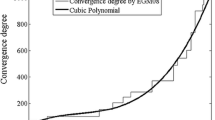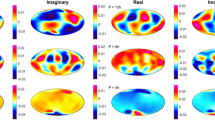Abstract
Subcrustal stress induced by mantle convection can be determined by the Earth’s gravitational potential. In this study, the spherical harmonic expansion of the simplified Navier–Stokes equation is developed further so satellite gradiometry data (SGD) can be used to determine the subcrustal stress. To do so, we present two methods for producing the stress components or an equivalent function thereof, the so-called S function, from which the stress components can be computed numerically. First, some integral estimators are presented to integrate the SGD and deliver the stress components and/or the S function. Second, integral equations are constructed for inversion of the SGD to the aforementioned quantities. The kernel functions of the integrals of both approaches are plotted and interpreted. The behaviour of the integral kernels is dependent on the signal and noise spectra in the first approach whilst it does not depend on extra information in the second method. It is shown that recovering the stress from the vertical–vertical gradients, using the integral estimators presented, is suitable, but when using the integral equations the vertical–vertical gradients are recommended for recovering the S function and the vertical–horizontal gradients for the stress components. This study is theoretical and numerical results using synthetic or real data are not given.


Similar content being viewed by others
References
Bagherbandi M. (2011) An isostatic Earth crustal model and its application, Doctoral Dissertation in Geodesy, Royal Institute of Technology (KTH), Stockholm, Sweden.
Bagherbandi M. and Eshagh M. (2011) Recovery of Moho’s undulations based on the Vening Meinesz–Moritz theory from satellite gravity gradiometry data: A simulation study, Adv. Space Res., 49(6):1097–1111.
Bagherbandi M. and Eshagh M. (2012) Crustal thickness recovery using an isostatic model and GOCE data, EPS, 64(11):1053–1057.
Bassin C., Laske G., and Masters G. (2000) The current limits of resolution for surface wave tomography in North America, EOS trans AGU, 81, F897.
Bruinsma S.L., Marty J.C., Balmino G., Biancale R., Foerste C., Abrikosov O. and Neumayer H. (2010) GOCE Gravity Field Recovery by Means of the Direct Numerical Method, presented at the ESA Living Planet Symposium, 27th June–2nd July 2010, Bergen, Norway; see also: earth.esa.int/GOCE.
Bölling K. and Grafarend E.W. (2005) Ellipsoidal spectral properties of the Earth’s gravitational potential and its first and second derivatives, J Geod, 79, 300–330.
ESA (1999) Gravity Field and Steady-State Ocean Circulation Mission, ESA SP-1233(1), Report for mission selection of the four candidate earth explorer missions, ESA Publications Division, pp. 217, July 1999.
Eshagh M. (2009a) On satellite gravity gradiometry, Doctoral dissertation in Geodesy, Royal Institute of Technology (KTH), Stockholm, Sweden.
Eshagh M. (2009b) Alternative expressions for gravity gradients in local north-oriented frame and tensor spherical harmonics, Acta Geophys., 58:215-243.
Eshagh M. (2011a) On integral approach to regional gravity field modelling from satellite gradiometric data, Acta Geophys., 59(1):29–54.
Eshagh M. (2011b) The effect of spatial truncation error on integral inversion of satellite gravity gradiometry data, Adv. Space Res., 47:1238–1247.
Eshagh M. (2012) Spectral combination of spherical gradiometric boundary-value problems: a theoretical study, Pure Appl. Geophys., 169:2201–2215.
Eshagh M. (2013) An integral approach to regional gravity field refinement using earth gravity models, J Geodyn, 68: 18–28.
Eshagh M. (2014a) A theoretical study on terrestrial gravimetric data refinement by Earth gravity models, Geophysical Prospecting, 62:158–171.
Eshagh M. (2014b) Determination of Moho discontinuity from satellite gradiometry data: linear approach, GRIB. 1(2):1–13.
Eshagh M. and Bagherbandi M. (2012) Quality description for gravimetric and seismic Moho models of Fennoscandia through a combined adjustment, Acta Geod. Geophys. Hung., 47(4):388–401.
Eshagh M., Bagherbandi M. and Sjöberg L.E. (2011) A combined global Moho model based on seismic and gravimetric data, Acta Geod. Geophys. Hung. 46(1):25–38.
Heiskanen W. and Moritz H. (1967) Physical Geodesy. W.H Freeman and company, San Francisco and London.
Kern M., Schwarz K.P. and Sneeuw N. (2003) A study on the combination of satellite, airborne and terrestrial gravity data, J Geod, 77:217–225.
Krarup T. (1969) A contribution to the mathematical foundation of physical geodesy, Report No. 44, Geodetic Institute, Copenhagen, Denmark.
Liu H.S. (1977) Convection pattern and stress system under the African plate, Phys. Earth, Planet. Int. 15:60–68.
Liu H.S. (1978) Mantle convection pattern and subcrustal stress under Asia, Phys. Earth, Planet. Int. 16:247–256.
Liu H.S. (1979) Convection-generated stress concentration and seismogenic models of the Tangshan Earthquake, Phys. Earth, Planet. Int. 19:307–318.
Liu H.S. (1980) Convection generated stress field and intra-plate volcanism, Tectonophysics, 65:225–244.
Martinec Z. (2003) Green’s function solution to spherical gradiometric boundary-value problems, J. Geod. 77, 41–49.
Migliaccio F., Reguzzoni M., Sanso F., Tscherning C.C., Veicherts M. (2010) Goce data analysis: the space-wise approach and the first space-wise gravity field model. In: Lacoste-Francis H. (ed) Proceedings of the ESA living planet symposium. ESA publication SP-686, ESA/ESTEC. ISBN:978-92-9221-250-6.
Mckenzie D. P. (1967) Some remarks on heat flow and gravity anomalies, J Geophys. Res. 72, 24, 6261–6273.
McNutt M. (1980) Implication of regional gravity for state of stress in the Earth’s crust and upper mantle, J Geophys. Res. 85, No. B11, 6377–6396.
Pavlis, N., Holmes, S.A., Kenyon S.C., and Factor J.K. (2008) An Earth Gravitational model to degree 2160: EGM08. Presented at the 2008 General Assembly of the European Geosciences Union, Vienna, Austria, April 13–18, 2008.
Petrovskaya M.S. and Vershkov A.N. (2006) Non-singular expressions for the gravity gradients in the local north-oriented and orbital reference frames, J. Geod. 80, 117–127.
Pick M. (1994) The geoid and tectonic forces, In: Geoid and its Geophysical interpretations EDS. P. Vanicek and N. Christou, CRC Press, 386 p.
Pick M. and Charvatova-Jakubkova I. (1988) Modification of the Runcorn’s equations on the convection flows, Stud. Geophys. Geod. 32:47–53.
Pail R., Bruinsma S., Migliaccio F., Foerste C. Goiginger H., Schuh W. D., Hoeck E., Reguzzoni M., Brockmann J. M., Abrikosov O., Veichert M., Fecher T., Mayrhofer R., Krasbutter I., Sanso F. and Tscherning C.C. (2011) First GOCE gravity field models derived by three different approaches, J Geod. 85:819–843.
Reguzzoni M. and Tselfes N. (2009) Optimal multi-step collocation: application to the space-wise approach for GOCE data analysis. J Geod, 83:13–29.
Reguzzoni M. and Sampietro D. (2012) A new global crustal Moho from based on GOCE data grids, presented at the first international GOCE Solid Earth workshop, Enschede, The Netherlands.
Reguzzoni M., Sampietro D. and Sanso F. (2013) Global Moho from combination of the CRUST2.0 model and GOCE data, Geophys. J. Int. (in press).
Ricard Y., Fleitout L. and Froidevaux C. (1984) Geoid heights and lithospheric stresses for a dynamic Earth, Annales Geophys, 2(3):267–286.
Runcorn S. K. (1964) Satellite gravity measurements and laminar viscous flow model of the Earth mantle, J. Geophys. Res., 69(20):4389–4394.
Runcorn S. K. (1967) Flow in the mantle inferred from the low degree harmonics of the geopotential, Geophys. J. R. astr. Soc. 14, 375–384.
Sampietro D. (2011) GOCE exploitation for Moho modeling and applications, in proceedings of the 4th international GOCE user workshop, Munich, Germany (vol. 31).
Sjöberg L.E. (1980) Least squares combination of satellite harmonics and integral formulas in physical geodesy. Gerlands Beitr Geophys. 89:371–377.
Sjöberg L.E. (1981) Least squares combination of satellite and terrestrial data in physical geodesy. An Geophys. 37:25–30.
Sjöberg L.E. (1986) Comparison of some methods of modifying Stokes’ formula, Bollettino di Geodesia e Scienze Affini 45(3):229–248.
Sjöberg L.E. (2011) Geoid determination by spectral combination of an Earth gravitational model with airborne and terrestrial gravimetry—A theoretical study. Stud. Geophys. Geod. 55(1):579–588.
Sjöberg L.E. and Eshagh M. (2012) A theory on geoid modelling by spectral combination of data from satellite gravity gradiometry, terrestrial gravity and an Earth gravitational model, Acta Geod. Geophys. Hung. 47(1):13–28.
Souriau M. and Souriau A. (1983) Global tectonics and the geoid, Phys. Earth and Planet. Inter. 33:126–136.
Tscherning C.C. and Rapp R. (1974) Closed covariance expressions for gravity anomalies, geoid undulations and deflections of vertical implied by anomaly degree variance models. Rep. 355. Dept. Geod. Sci. Ohio State University, Columbus, USA.
van Gelderen M. and Rummel R. (2001) The solution of the general boundary value problem by least-squares, J. Geod. 75:1–11.
Acknowledgments
The author is thankful to Professor Lars E. Sjöberg at Royal Institute of Technology (KTH), Stockholm, Sweden for introducing the subject.
Author information
Authors and Affiliations
Corresponding author
Appendices
Appendix A: Proofs of Closed-Form Formulae
All of the closed formulae can be derived based on the well-known formula of Legendre expansion of distance (cf. Heiskanen and Moritz 1967, p. 33):
In order to obtain the closed formula for the kernel presented in Eq. (11c) take the derivative of both sides of (15) and multiply the results by:
Now if another derivative with respect to s is taken, the results will be
when the contributions of zero- and first-degrees are removed from Eq. (17) the closed-form formula of the kernel of Eq. (11c) is derived.
Similarly, it will not be difficult to show that Eq. (13c) is
and by removing the contributions of the first- and second-degree Eq. (10d) we have:
Again, when the contributions of the zero- and first-degree are removed the kernel function will be obtained.
The proof of Eq. (12c) is simply followed based on the following relation:
The following closed-form formula has been derived by Martinec (2003):
To derive the kernel of Eq. (11f) it is enough to consider s = 1 and removing the first degree contribution.
Appendix B: Azimuths α and \( \alpha^{\prime} \)
Based on the well-known rule of cosine in spherical trigonometry one can write (cf. Heiskanen and Moritz 1967, p. 113):
and cos α will be:
Substitution of Eq. (23) into Eq. (22) and simplification of the results yields:
According to sine rule, one can simply obtain:
The associated Legendre function of degree and order 1 has the following relation with the derivative of Legendre polynomials (cf. Heiskanen and Moritz 1967, p. 22):
According to Eq. (26) the derivatives of Legendre polynomials with respect to θ and λ will be (Heiskanen and Moritz 1967, p. 22):
By taking the derivatives of Eq. (22) with respect to θ and λ we obtain:
Finally, we can write:
Similarly, we can write the following relation for the azimuth from the integration point to the computation point:
In such a case the derivatives of Eq. (22) should be taken now with respect to θ ′ and λ ′. After simplification of the results we have:
Now according to Eq. (26) and similar to Eqs. (27) and (28) we obtain:
Rights and permissions
About this article
Cite this article
Eshagh, M. From Satellite Gradiometry Data to Subcrustal Stress Due to Mantle Convection. Pure Appl. Geophys. 171, 2391–2406 (2014). https://doi.org/10.1007/s00024-014-0847-2
Received:
Revised:
Accepted:
Published:
Issue Date:
DOI: https://doi.org/10.1007/s00024-014-0847-2




